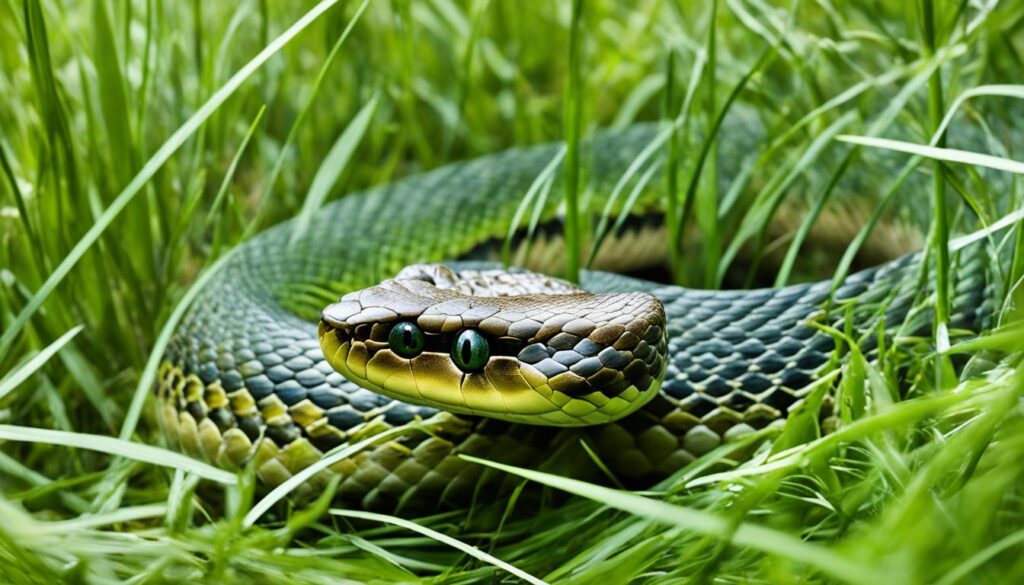New Zealand, a stunning island nation located over 1,000 miles southeast of Australia, is renowned for its unique wildlife and awe-inspiring landscapes. However, one notable absence from this beautiful country is snakes. Unlike many other parts of the world, New Zealand has never had native snake populations. This is due to the country’s isolated position and robust biosecurity measures that prevent the introduction and establishment of these reptiles.
New Zealand is one of the few large islands in the world, such as Antarctica, Iceland, Ireland, and Newfoundland, where snakes have never been found. The absence of snakes in New Zealand plays a crucial role in preserving the delicate balance of the local ecosystem, ensuring the protection of native fauna and flora.
Key Takeaways:
- New Zealand does not have native land snakes.
- The absence of snakes in New Zealand is due to its isolated position.
- The introduction of snakes could have a detrimental impact on the local wildlife.
- Strict biosecurity measures prevent snakes from establishing populations in New Zealand.
- New Zealand’s snake-free status ensures public safety and allows for enjoyable outdoor activities.
Snakes in New Zealand: The Facts
While New Zealand is famously known for its lack of native land snakes, there have been occasional sightings of sea snakes in the country. Two species, the yellow-bellied sea snake (Pelamis platurus) and the banded sea krait (Laticauda colubrina), sometimes swim long distances from the South Pacific islands, New Guinea, Australia, and Southeast Asia to the shores of New Zealand. These sea snakes, although small in size, possess venom and can pose a potential threat to the local fauna and humans. Since 1930, there have been 35 confirmed sightings of sea snakes in New Zealand, emphasizing the rarity of encountering any snake species in the country.
The chances of coming across either a sea snake or a land snake in New Zealand remain quite low. Nonetheless, the presence of any snake species in the country warrants attention due to the potential risks they may pose to the delicate ecosystem and public safety.
Snake Sightings and Invasions in New Zealand
While snakes are not native to New Zealand, there have been instances where snakes have made their way to the country through ships or other means of transport. In the last 10 years, 59 snakes have been discovered in New Zealand, with 29 of them being found at the border and 30 slipping past border security. Most of these snakes entered the country through imported goods such as building materials, furniture, and landscape supplies. The Ministry for Primary Industries and local authorities take immediate action to eliminate the threat and prevent the snakes from spreading. These invasive snakes are either destroyed or captured and held in captivity if they pose a low-risk breeding population. High-risk or breeding populations are eradicated to protect the local environment.
The Need for Snake Protection in New Zealand
While some may view New Zealand’s anti-snake policy as excessive, it is rooted in the country’s unique ecosystem and the need to protect native species. Over the past 1,000 years since humans arrived in New Zealand, the islands have already experienced a significant loss of native species, including birds, frogs, and plant species.
The introduction of predatory snakes could further disrupt the delicate balance of the environment and endanger additional species. Therefore, strict measures are in place to prevent snakes from establishing populations in New Zealand.
The country’s biosecurity system and trained personnel work diligently to detect and handle any snake sightings, ensuring the continued preservation of New Zealand’s natural environment.

Snake Discoveries and Eradication Efforts
Over the past 10 years, there have been several notable snake discoveries in New Zealand. In 2010, two live snakes were found in Auckland, followed by snake sightings in Palmerston North, Whangaparaoa, and New Plymouth in subsequent years. The most significant year for snake discoveries was 2015 when four live snakes were found, including one in New Plymouth and three in Auckland. Since then, there have been annual discoveries of one snake each year, mainly in Auckland, with a few instances of snakes slipping into the South Island in Queenstown and Te Anau. The most recent snake discovery occurred in 2019 at Queenstown Airport. These discoveries highlight the effectiveness of New Zealand’s biosecurity measures and the success in preventing the establishment of a snake population.
Snake Discoveries in New Zealand (2010-2019)
| Year | Location |
|---|---|
| 2010 | Auckland |
| 2011 | Palmerston North |
| 2012 | Whangaparaoa |
| 2013 | New Plymouth |
| 2014 | Auckland |
| 2015 | New Plymouth |
| Auckland | |
| 2016 | Auckland |
| 2017 | Auckland |
| 2018 | Auckland |
| 2019 | Queenstown Airport |
New Zealand’s Unique Wildlife and Conservation Efforts
New Zealand is home to a diverse range of unique wildlife, including several native bird and lizard species. The absence of snakes in the country has played a vital role in allowing these native species to thrive without the threat of predation. This has contributed to the preservation of New Zealand’s distinct ecological balance.
However, the country has faced challenges in recent years in safeguarding its native flora and fauna. Invasive species and habitat loss have posed significant threats to the delicate ecosystem. Tragically, nearly one-third of all bird species in New Zealand have become extinct, and many others are classified as endangered or threatened.
Recognizing the importance of protecting New Zealand’s unique wildlife, the government has implemented stringent regulations to preserve the country’s delicate ecosystem. These wildlife regulations are part of a broader commitment to conservation efforts, ensuring the long-term sustainability of the native ecosystem.
Conservation organizations and initiatives play a crucial role in the preservation of New Zealand’s wildlife. These efforts focus on habitat restoration, species reintroduction, and combating invasive species. By restoring and protecting natural habitats, these initiatives create safe environments for native species to thrive and help prevent further loss of biodiversity.
New Zealand’s unique wildlife and conservation efforts highlight the country’s commitment to preserving its natural heritage. By implementing strict regulations and supporting conservation initiatives, New Zealand strives to ensure the future survival and prosperity of its native species.
New Zealand’s Snake-Free Reputation and Public Safety
New Zealand’s unique distinction as a snake-free country plays a crucial role in ensuring public safety and fostering a sense of security for residents and visitors alike. With no native land snakes present, outdoor enthusiasts can explore the country’s stunning landscapes, engage in exhilarating hikes, and enjoy various recreational activities without the worry of encountering venomous snakes.
The New Zealand government and local authorities have implemented stringent measures to maintain the country’s snake-free status and safeguard public safety. These efforts include robust biosecurity protocols and a swift response system to address any potential snake sightings or invasion threats. By remaining vigilant and proactive, New Zealand actively preserves its pristine environment and protects its diverse wildlife.
In order to sustain its snake-free reputation, public participation is crucial. Reporting any snake sightings promptly to the appropriate authorities helps maintain effective detection and eradication processes. The cooperation of residents and visitors in adhering to biosecurity measures not only ensures public safety but also safeguards the fragile ecosystem that characterizes New Zealand’s unique biodiversity.
New Zealand’s commitment to its snake-free policy exemplifies its dedication to public safety and demonstrates the country’s ongoing efforts to protect its inhabitants and native wildlife. By upholding stringent biosecurity measures and encouraging citizen engagement, New Zealand continues to preserve its unparalleled reputation as a safe haven free from snake-related hazards.
FAQ
Are there snakes in New Zealand?
No, New Zealand does not have any native land snakes. However, there have been occasional sightings of sea snakes.
What types of snakes have been sighted in New Zealand?
The yellow-bellied sea snake and the banded sea krait are known to visit New Zealand’s shores from the South Pacific islands, New Guinea, Australia, and Southeast Asia.
Have snakes been found in New Zealand?
Yes, in the last 10 years, there have been 59 snake discoveries in New Zealand. Most of these snakes entered the country through imported goods.
What happens when snakes are found in New Zealand?
The Ministry for Primary Industries and local authorities take immediate action to eliminate the threat and prevent the snakes from spreading. Invasive snakes are either destroyed or captured and held in captivity if they pose a low-risk breeding population.
Why is New Zealand strict about preventing snakes from establishing populations?
The absence of snakes in New Zealand is crucial for the protection of the local wildlife. The introduction of snakes could have a detrimental impact on the native ecosystem.
How effective are New Zealand’s biosecurity measures in preventing snakes?
Over the past 10 years, there have been several notable snake discoveries, but New Zealand’s biosecurity measures have been successful in preventing the establishment of a snake population.
What is the impact on New Zealand’s unique wildlife?
The absence of snakes allows native species to flourish without the threat of predation. However, the country has faced challenges with invasive species and habitat loss, leading to the extinction and endangerment of many species.
Is New Zealand safe from venomous snakes?
Yes, New Zealand’s snake-free status ensures public safety, allowing residents and visitors to enjoy outdoor activities without the fear of encountering venomous snakes.







